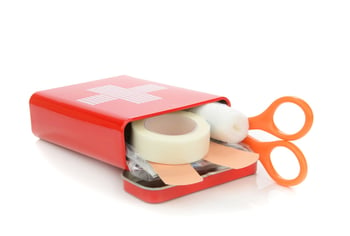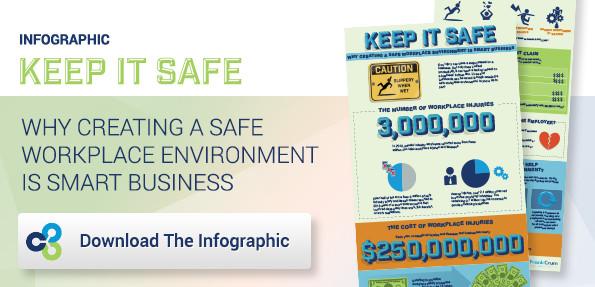 Having a safe workplace is smart business. By avoiding injuries, lost work time, and workers' compensation claims, you can drive productivity and increase employee morale.
Having a safe workplace is smart business. By avoiding injuries, lost work time, and workers' compensation claims, you can drive productivity and increase employee morale.
Being proactive before an accident occurs is the key to improving safety performance, and sustaining it over time.
Over half of the 3 million private industry injury and illness cases reported in 2013 were serious, and involved missing days from work and other restrictions. This begs the question, “How many of these accidents could have been avoided -- and how?”
In this article, we are going to showcase some things to consider when creating a safety program. Every company is different, and work roles vary greatly, but a proactive approach and an openness to consider multiple avenues to achieve safety standards can benefit companies of every type.
And remember, improving safety and avoiding accidents will have a positive impact on your employees, your business continuity and your bottom line.
What Companies Can do to Create a Safer Workplace
A great place to start is with your supervisors and managers, and then those individuals can reinforce safety priorities and behaviors throughout the organization. Many businesses fail to properly instruct supervisors and managers, and to make them responsible for enforcing safety.
So start by identifying the management personnel who can receive training and then assume more formal responsibility for safety performance and accident avoidance.
Consider some of these best practices to jumpstart safety training in your business:
- Require your top-level staff to assume responsibility for safety: if your supervisors take safety seriously and you hold them accountable for safety performance, inevitably the trickle-down effect will happen, and your employees will know that safety is a company priority and expectation
- Provide safety training: OSHA has a variety of safety programs available to businesses to implement safe practices. Also, by partnering with a Professional Employer Organization (PEO), you have access to a team of safety management specialists who can deliver customized resources that are easy to adopt and implement
- Offer ongoing safety classes and workshops: a common mistake is thinking that safety training is “done.” It’s like saying a football team is ready for a big game because they practiced once. Ongoing drills, training, reminders, communication and education is essential. Offering safety workshops and illness prevention tips can help your employees perform their work more safely. This is not a wasted resource; in fact, it’s much less expensive than an average workers’ comp claim when a serious accident does occur
The Cost of a Claim
When you compare the cost of a claim to the cost of a good safety prevention program, you’ll opt for prevention virtually every time. For example, a single accident where you might experience $1,500 in claim fees can actually cost you over $8,000 in real costs when you take into consideration some of the following extraneous expenses:
- Lost productivity from staff - downtime as everyone stares at the injury or morale issues as nobody wants to work that job position
- OSHA and/or legal fees
- Costs associated with overtime or training another employee to fill in the injured worker’s position
- Damaged equipment
Do you have a plan for preventing injuries, and not waiting until they happen?
Why Being Proactive is Essential
Differentiating proactive versus reactive practices is imperative to creating a thorough workplace safety process. Let’s take a look as a potential situation:
Bob is working on a construction site setting the upper rows of concrete blocks on a residential property. Due to the height involved, Bob has to use a scaffold that was set up the prior day by another employee. When the site supervisor comes to check on Bob’s progress he notices the scaffolding is not set up correctly but as Bob is almost done with the job he decides to not mention anything and lets Bob continue with the job.
Later in the workday, the scaffolding shifts due to the improper set-up and Bob falls 4 feet to the ground. In the process of the scaffolding collapsing, Bob also drops his tools which hit Steve in the head as he was walking by to take his lunch break.
What do you think could have been done pro-actively to avoid injury to 2 employees?
- During the new employee orientation process, Bob should have been instructed to review the set-up of scaffolding prior to use (conducting a Job Hazard Analysis)
- At the beginning of the work shift the scaffolding should have been checked and signed off that it was in proper condition. Equipment can “mysteriously” change condition overnight on occasion
- The site supervisor should have stopped the work and corrected the problem immediately rather than allowing Bob to continue his work
- The employee on the ground should have been trained and reminded to wear a hard hat
The list of pro-active activities can go on – Daily toolbox talks, Safety Teams, Competent Person training, and other accountability systems that are not tied to discipline. It is important for supervisors and employees to report any hazardous conditions they see, no matter how small or insignificant it seems.
This jobsite is now short 2 employees for at least a week putting them behind in schedule and costing them far more in labor and profit than the fees associated with the claim event.
The Takeaway
Having a proactive approach to safety can help you avoid workplace accidents along with the morale issues and expenses that come with injuries. Is your workplace primed for safety? Click the link below to access our infographic on keeping it safe in the workplace, to learn more, or feel free to contact us!





